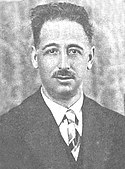
Back الانتخابات الإسبانية العامة 1936 Arabic Парламенцкія выбары ў Іспаніі (1936) Byelorussian Eleccions generals espanyoles de 1936 Catalan Elecciones generales de España de 1936 Spanish 1936ko Espainiako hauteskunde orokorrak Basque Élections générales espagnoles de 1936 French Eleccións xerais de España de 1936 Galician Elezioni generali in Spagna del 1936 Italian 1936년 스페인 총선거 Korean Spaanse parlementsverkiezingen 1936 Dutch
| |||||||||||||||||||||||||||||||||||||||||||||||||||||||||||||||||||||
All 473 seats of the Congress of Deputies 237 seats needed for a majority | |||||||||||||||||||||||||||||||||||||||||||||||||||||||||||||||||||||
|---|---|---|---|---|---|---|---|---|---|---|---|---|---|---|---|---|---|---|---|---|---|---|---|---|---|---|---|---|---|---|---|---|---|---|---|---|---|---|---|---|---|---|---|---|---|---|---|---|---|---|---|---|---|---|---|---|---|---|---|---|---|---|---|---|---|---|---|---|---|
| Turnout | 72.95% | ||||||||||||||||||||||||||||||||||||||||||||||||||||||||||||||||||||
| |||||||||||||||||||||||||||||||||||||||||||||||||||||||||||||||||||||
| |||||||||||||||||||||||||||||||||||||||||||||||||||||||||||||||||||||
Legislative elections were held in Spain on 16 February 1936. At stake were all 473 seats in the unicameral Cortes Generales. The winners of the 1936 elections were the Popular Front, a left-wing coalition of the Spanish Socialist Workers' Party (PSOE), Republican Left (Spain) (IR), Esquerra Republicana de Catalunya (ERC), Republican Union (UR), Communist Party of Spain (PCE), Acció Catalana (AC), and other parties. Their coalition commanded a narrow lead over the divided opposition in terms of the popular vote, but a significant lead over the main opposition party, Spanish Confederation of the Autonomous Right (CEDA), in terms of seats. The election had been prompted by a collapse of a government led by Alejandro Lerroux, and his Radical Republican Party. Manuel Azaña would replace Manuel Portela Valladares, caretaker, as prime minister.
The electoral process and the accuracy of the results have been historically disputed. Some of the causes of this controversy include the formation of a new cabinet before the results were clear, a lack of reliable electoral data, and the overestimation of election fraud in the official narrative that justified the coup d'état.[1][2][3][4] The topic has been addressed in seminal studies by renowned authors such as Javier Tusell and Stanley G. Payne.[5][6] A series of recent works has shifted the focus from the legitimacy of the election and the government to an analysis of the extent of irregularities.[7][8] Whilst one of them suggests that the impact of fraud was higher than previously estimated when including new election datasets, the other disputes their relevance in the election result.[7][8]
The elections were the last of three legislative elections held during the Spanish Second Republic, coming three years after the 1933 general election which had brought the first of Lerroux's governments to power. The uncontested victory of the political left in the elections of 1936 triggered a wave of collectivisation, mainly in the south and west of the Iberian Peninsula, engaging up to three million people,[9] which has been identified as a key cause of the July coup.[10] The right-wing military coup initiated by Gens. Sanjurjo and Franco, the ensuing civil war, and the establishment of Franco's dictatorship ultimately brought about the end of parliamentary democracy in Spain until the 1977 general election.
Cite error: There are <ref group=nb> tags on this page, but the references will not show without a {{reflist|group=nb}} template (see the help page).
- ^ "Revista de Libros: «Las elecciones generales de febrero de 1936: una reconsideración historiográfica» de Enrique Moradiellos". www.revistadelibros.com (in Spanish). 11 September 2017. Retrieved 2021-07-05.
- ^ Arrarás Iribarren, Joaquín (1964). Historia de la Segunda República Española. Madrid: Editora Nacional.
- ^ Gobernación, Espana Ministerio de la (1939). Dictamen de la Comisión sobre ilegitimidad de poderes actuantes en 18 de Julio de 1936 (Report). Editora Nacional.
- ^ Bécarud, Jean (1967). La Segunda República Española. Madrid: Taurus.
- ^ Tusell, Javier (1971). Las elecciones del Frente Popular. Madrid: Edicusa.
- ^ Payne, Stanley G. (2019). La revolución española (1936-1939) : un estudio sobre la singularidad de la Guerra Civil. Barcelona. ISBN 978-84-670-5533-7. OCLC 1100348435.
{{cite book}}: CS1 maint: location missing publisher (link) - ^ a b Álvarez Tardío, Manuel (2017). 1936, fraude y violencia en las elecciones del Frente Popular. Roberto Villa García. Barcelona. ISBN 978-84-670-4946-6. OCLC 976020486.
{{cite book}}: CS1 maint: location missing publisher (link) - ^ a b González Calleja, Eduardo; Sánchez Pérez, Francisco (2018-10-01). "Revisando el revisionismo. A propósito del libro 1936. Fraude y violencia en las elecciones del Frente Popular". Historia Contemporánea. 3 (58): 851–881. doi:10.1387/hc.19831. hdl:10810/38374. ISSN 2340-0277. S2CID 240078416.
- ^ Gaston Leval, Social Reconstruction in Spain, London, 1938. Discussed in Woodcock, p. 373.
- ^ see James Woodcock, Anarchism (1960), London: Penguin, 1970, pp. 365–375.
© MMXXIII Rich X Search. We shall prevail. All rights reserved. Rich X Search







